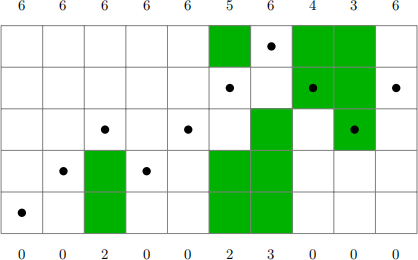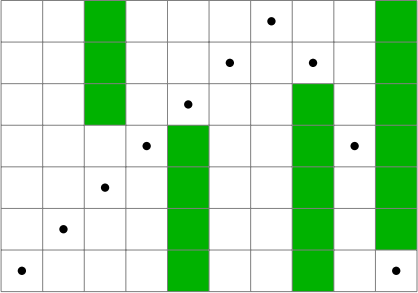关键词 > COMP3121/9101
COMP3121/9101 23T2 — Assignment 3
发布时间:2023-11-07
Hello, dear friend, you can consult us at any time if you have any questions, add WeChat: daixieit
COMP3121/9101 23T2 — Assignment 3
Question 1 OurExperience
You are collecting survey results from k students over n days. Each day, all k students answer the survey by providing a real number between 0 and 10 representing their stress level. For each student, their survey responses over the n days are given in an array Si [1..n].
You want to combine all k survey responses to report to your boss how the students are feeling. You are going to make a report which uses one of the responses from each day, and you want to pick-and-choose responses so that students appear to be emotionally stable. You have designed a heuristic to do so:
Choose a sequence of survey responses R[1..n], where each R[i] is the response from one of the students on day i, minimising the change between each response in the sequence. That is, choose a sequence R where each R[i] is one of {S1 [i], S2 [i],..., Sk [i]} minimising the fluctuation

For example, with n = 4 and k = 3, if you measure the results
S1 = [2, 5, 8, 9.9], S2 = [5, 2.5, 1, 4], S3 = [10, 3,π2 , 7],
then the optimal sequence is R = [5, 5, 8, 7] with
f = |5 − 5| + |5 − 8| + |8 − 7| = 4,
obtained by taking the measurements from sensors 2 , 1, 1, 3.
1.1 [6 marks] Consider this attempt to solve the problem with a greedy algorithm:
Start with S1 [1], then for each subsequent day choose the survey response closest to the previous one. Repeat by starting at each S2 [1], S3 [1],..., Sk [1], and of these, choose the sequence with the minimum fluctuation.
Show that this algorithm does not solve the problem correctly by giving a counterexample. You must provide n, k, the k sequences of survey responses, the answer (R and f) produced by the greedy algorithm, and the correct answer. Your example must have n ≤ 4 and k ≤ 3.
1.2 [14 marks] Design an O(nk2 ) algorithm to find the minimal fluctuation of an optimal sequence R, and the sequence of survey responses used to achieve this fluctuation. If there are multiple optimal sequences, your algorithm can find any one of them.
Answers that determine only the minimal fluctuation (without finding the sequence of re- sponses) will receive at most 10 marks for this part.
Question 2 Crappy Bird
Crappy Bird is a game where you control a bird starting at (1 , 1) in a grid with m rows of n columns (where m ≥ 2). Some columns j (1 ≤ j ≤ n) have pipes from the bottom of the screen to row PipeUp(j), and some have pipes from the top of the screen to row PipeDown(j). If a column j has no pipe from the bottom then PipeUp(j) = 0, and if it has no pipe from the top then PipeDown(j) = m + 1. The goal is to reach row n while hitting as few pipes as possible. If you exit the screen by flying too low or too high, you lose the game immediately!
Each step of the game, the bird moves one column to the right. Additionally, if you tap the screen the bird moves one row up, otherwise it falls one row down. That is, if the bird is at (x,y) at the some step, then it can be at (x + 1, y + 1) or (x + 1, y − 1) in the next step.
For example, this is a valid path which hits two pipes. The PipeUp and PipeDown values are shown below and above the grid respectively.

A better path is achieved by going down from (6, 4) instead of up, hitting only one pipe.

2.1 [10 marks] Design an algorithm that runs in O(mn) time, and determines the fewest pipes the bird can run into without exiting the screen.
2.2 [7 marks] The developers have realised that the game’s implementation of gravity is entirely unrealistic! To fix it, they have patched the game to include acceleration for downwards move- ment. When the bird begins falling (after a sequence of upwards movements), it first falls 1 unit downwards. If it falls again in the next step, it falls 2 units, then 3, 4, and so on. That is, the kth consecutive time the bird falls, it moves from (x,y) to (x + 1, y − k).
For example, the bird may take this path:

Note that no pipes are hit, as at each step the bird is in a cell that does not coincide with a pipe.
The movement between positions is not considered.
Design an algorithm that runs in O(m2 n) time, and determines the fewest pipes the bird can run into.
2.3 [3 marks] Describe how the algorithm for part 2.2 can be improved to O(nm√![]() m). You do not need to restate the entire algorithm - just describe and justify how you would change the algorithm to achieve this.
m). You do not need to restate the entire algorithm - just describe and justify how you would change the algorithm to achieve this.
You may choose the skip this part and instead give an O(nm√m) algorithm for part 2 If you do, your answer to 2.2 will be marked for both parts.
Question 3 Dance!
In the arcade game Dance Dance Revolution (DDR), players stand on a stage and hit arrows as they scroll across the screen. More specifically, a sequence of n arrows (![]() ,
, ![]() ,
, ![]() ,
, ![]() ) will scroll across the screen, and as each arrow hits the top of the screen, the player must stand on the corresponding arrow on the stage.
) will scroll across the screen, and as each arrow hits the top of the screen, the player must stand on the corresponding arrow on the stage.
We play a variant of DDR, aptly named Don’t Dance Revolution (DDR2), where the goal is to play the game like DDR but move as little as possible. The game plays like DDR except when an arrow reaches the top of the screen and the player already has a foot on the correct arrow, then the player is awarded one lazy point. If neither foot is on the correct arrow, then the player must move exactly one foot from its current location to the correct arrow on the platform.
Unfortunately, the game is a bit unforgiving: any wrong move will cause the player to lose the game and all of their lazy points. Wrong moves include:
. Failing to step on the correct arrow.
. Moving more than one foot at any given time.
. Moving either foot when the player is already stepping on the correct arrow.
You are given a sequence A of n arrows. Assume that your left foot starts on ![]() and your right foot starts on
and your right foot starts on ![]() , and you have memorised the entire sequence of arrows.
, and you have memorised the entire sequence of arrows.
For example, consider the following sequence: ![]() . We can earn up to two lazy points as follows:
. We can earn up to two lazy points as follows:

3.1 [4 marks] Show that it is always possible to earn at least ⌊n/4⌋ lazy points during a round of DDR2.
3.2 [16 marks] Design an O(n) algorithm to determine the maximum number of lazy points you can earn in a round of DDR2.

